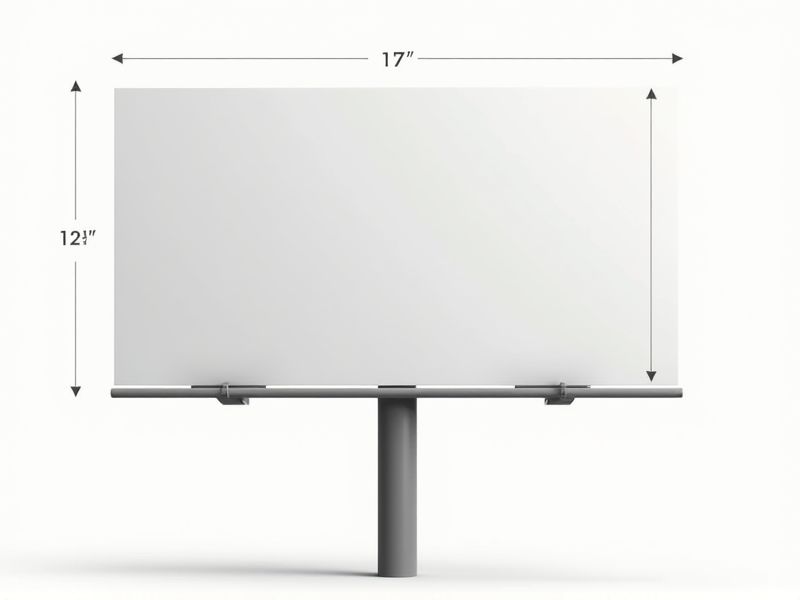
When planning a billboard advertisement, it's helpful to know the standard dimensions used in the industry. The most common size for a roadside billboard is 14 feet high by 48 feet wide, also known as a "bulletin" board. Smaller options, like a 10.5 feet by 36 feet billboard, are also widely used in urban or high-traffic areas. Knowing these standard dimensions can help you design your ad effectively and ensure it fits the available space perfectly.
Visibility And Readability
Billboard design revolves around two critical aspects: visibility and readability. A common recommendation is to use a font size of at least 10 inches for optimum legibility from a distance of 500 feet. Contrasting colors play a significant role, with dark lettering on light backgrounds enhancing visual clarity, thereby ensuring your message is effortlessly absorbed by passing motorists. Effective use of imagery, coupled with minimal text--ideally no more than six to eight words--maximizes audience engagement and impact.
Industry Standard Sizes
Billboards typically adhere to industry standard sizes to maximize visibility and readability. Common dimensions include 14x48 feet for traditional highway billboards and 10x30 feet for urban settings. These sizes help ensure that messages can be easily seen from a distance, often at speeds of 55 miles per hour or more. Understanding these standards allows you to effectively design your advertising campaigns for optimal impact and engagement.
Aspect Ratio Consistency
Aspect Ratio Consistency is crucial for billboard effectiveness, ensuring that advertisements maintain clarity across various display formats. The ideal aspect ratio for billboards typically ranges from 4:1 to 10:1, allowing for flexibility while preserving visual integrity. This consistency enhances viewer comprehension, as 70% of onlookers can quickly grasp the message when images and text are proportionally balanced. To maximize impact, consider scaling your designs to fit these standard ratios, leading to more engaging and memorable campaigns.
Cost Implications
Billboard advertising typically incurs costs that range from $1,500 to $30,000 per month, depending on location, size, and visibility. The overall expense includes production costs, which can add an extra $1,000 to $5,000 for design and printing. High-traffic areas often demand a premium, with costs escalating by 300% or more in metropolitan regions. To ensure a favorable return on investment, you should analyze the projected audience reach and engagement metrics of your selected billboard.
Design Flexibility
Billboard design flexibility enables brands to create custom displays that adapt to varied locations and audiences, enhancing engagement. With a standard size of 14 feet by 48 feet, outdoor billboards offer ample space for eye-catching visuals and concise messaging. Incorporating dynamic elements, such as digital displays, can increase viewer interaction by up to 300%, making them ideal for high-traffic areas. Your campaign can benefit from using versatile layouts and materials, ensuring the billboard remains relevant and visually appealing.
Audience Reach
Billboard advertising typically emphasizes audience reach, measuring effectiveness by potential impressions. A strategically placed billboard in a high-traffic area can generate over 20,000 daily views, making it a powerful medium for targeting local consumers. According to recent studies, 68% of people in urban locations notice billboards, reflecting their ability to capture attention. For your marketing strategy, incorporating billboards in densely populated areas can significantly enhance brand visibility and consumer engagement.
Compliance With Regulations
Billboard advertising must adhere to strict regulations to ensure safety and visibility. These regulations often govern the size, placement, and brightness of billboards, requiring compliance with local zoning laws. Large-scale billboards can reach dimensions up to 14 feet high and 48 feet wide, with restrictions varying by city or municipality. Failure to comply can result in fines that may exceed $1000, significantly impacting your advertising investments.
Material And Structure
Billboards typically prioritize materials such as vinyl, mesh, and poster paper for durability and visual impact, ensuring they withstand various weather conditions. Structurally, many billboards utilize steel or aluminum frames to provide robust support, allowing for larger sizes that can reach dimensions of up to 14 by 48 feet. Proper lighting is essential, with LED systems ensuring visibility both day and night, while maintaining energy efficiency. Understanding these materials and structural elements helps you choose the right billboard design for maximum audience engagement.
Installation And Maintenance
Billboard installation requires precise measurements, with a typical height ranging from 14 to 48 feet, ensuring maximum visibility for drivers. Proper maintenance is essential, involving routine inspections at least once every six months to address wear and tear, which can prevent costly repairs and enhance safety. During installation, it's crucial to secure permits, with differing regulations across states affecting placement and design, impacting your advertising strategy. Investing in LED technology can reduce energy costs by up to 80%, while also offering dynamic content capabilities that elevate engagement with potential customers.
Market And Location Suitability
Billboard advertising effectiveness hinges on market and location suitability, with 75% of successful campaigns attributed to strategic placement. Urban areas with high foot traffic, such as Times Square in New York, generate over 1.5 million daily impressions, enhancing brand visibility. Selecting the right demographic is crucial; targeting specific age groups, with millennials representing up to 30% of the outdoor advertising audience, can significantly impact engagement. Your billboard's message should resonate with local trends, ensuring relevancy and maximizing return on investment.
